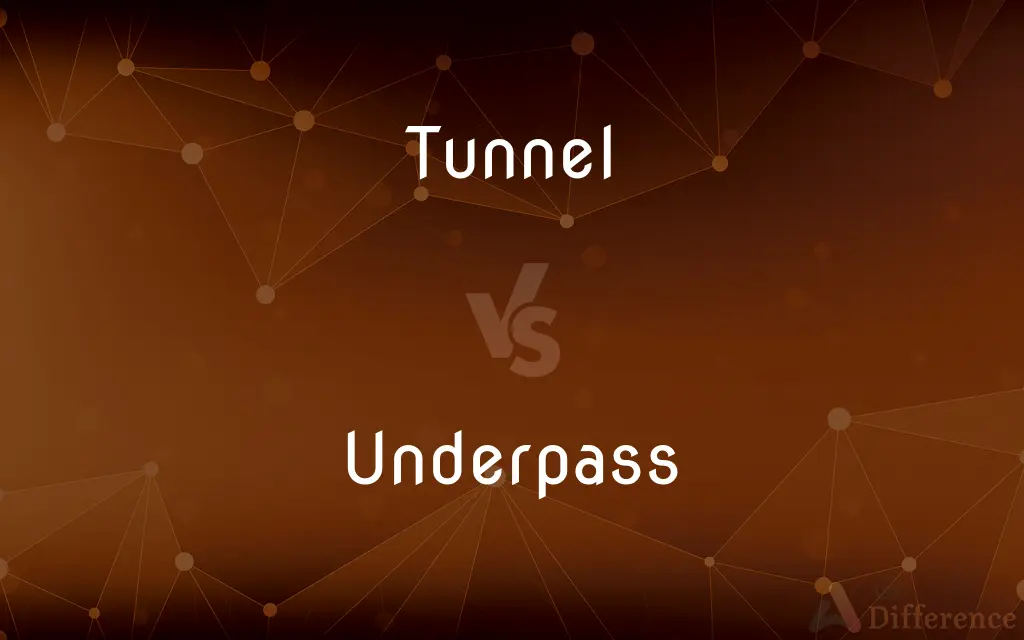Tunnel vs. Underpass — What's the Difference?
By Fiza Rafique & Urooj Arif — Updated on April 22, 2024
A tunnel is an enclosed passageway through or under an obstacle, typically used for transportation, while an underpass specifically refers to a road or pathway that crosses under another road or railway.

Difference Between Tunnel and Underpass
Table of Contents
ADVERTISEMENT
Key Differences
Tunnels are engineered passages that enable transportation through or under natural or man-made obstacles, such as mountains or cities. On the other hand, underpasses are typically constructed to allow vehicles, pedestrians, or cyclists to pass beneath railways, roads, or other barriers without intersecting the traffic flow above.
While tunnels can be quite lengthy and are used for a variety of purposes including road, rail, and utility pathways, underpasses are generally shorter and focus solely on providing a safe crossing beneath a busy intersection or similar structure. Tunnels may involve complex construction techniques and can extend for miles, featuring ventilation systems and emergency exits. Conversely, underpasses are simpler in design and construction, mainly serving urban areas to reduce traffic congestion.
Tunnels often require significant engineering to address challenges like water ingress and structural integrity. Whereas underpasses, although also requiring engineering consideration, primarily deal with ground conditions and the load-bearing requirements of the structure above.
Tunnels can be part of strategic infrastructure supporting national transportation networks or utilities, reflecting their broader utility and scale. In contrast, underpasses are more localized solutions aimed at improving pedestrian or vehicular traffic in specific areas.
Comparison Chart
Purpose
Transport through/under obstacles (mountains, water)
Crossing under roadways or railways
ADVERTISEMENT
Length
Variable, often long
Usually short
Construction Complexity
High, with advanced engineering and safety features
Lower, focused on local infrastructure needs
Use Case
Broad (transport, utilities, military)
Primarily traffic management in urban areas
Design Considerations
Ventilation, emergency exits, lighting
Ground stability, load-bearing structures
Compare with Definitions
Tunnel
A subterranean passageway.
The new metro project includes a tunnel beneath the river.
Underpass
A pedestrian crossing below road level.
The underpass near the park is frequently used by joggers.
Tunnel
A covered way excavated in the earth.
During the war, soldiers used tunnels for movement.
Underpass
A lower-level passage integrated into urban infrastructure.
The underpass connects two parts of the university campus.
Tunnel
A passage made by an animal under the ground.
Moles create tunnels in search of food.
Underpass
A part of urban planning aimed at traffic decongestion.
City planners propose an underpass to solve the bottleneck.
Tunnel
A method of underground transport.
Freight trains pass through the tunnel connecting the two cities.
Underpass
A road or pathway going beneath another road or a railway.
The new underpass has eased the traffic congestion downtown.
Tunnel
A tunnel is an underground passageway, dug through the surrounding soil/earth/rock and enclosed except for entrance and exit, commonly at each end. A pipeline is not a tunnel, though some recent tunnels have used immersed tube construction techniques rather than traditional tunnel boring methods.
Underpass
A construction project enhancing safety for pedestrians.
The city added an underpass to improve pedestrian safety at the intersection.
Tunnel
An artificial underground passage, especially one built through a hill or under a building, road, or river
The Mersey tunnel
A road tunnel through the Pyrenees
The tunnel mouth
Underpass
A road or pedestrian tunnel passing under a road or railway.
Tunnel
Short for wind tunnel
Underpass
A passage underneath something, especially a section of road that passes under another road or a railroad.
Tunnel
A long, half-cylindrical enclosure used to protect plants, made of clear plastic stretched over hoops
Cover plants in rows with a cloche tunnel
Underpass
An intersection formed in this way.
Tunnel
Dig or force a passage underground or through something
The insect tunnels its way out of the plant
He tunnelled under the fence
Underpass
A passage that crosses a road, railroad or similar obstacle in a tunnel underneath it.
Tunnel
(of a particle) pass through a potential barrier.
Underpass
An underground tunnel or passage enabling pedestrians to cross a road or railway
Tunnel
An underground or underwater passage.
Tunnel
A passage through or under a barrier such as a mountain.
Tunnel
A tube-shaped structure.
Tunnel
To make a tunnel through or under
Tunneling the granite.
Tunnel
To produce, shape, or dig in the form of a tunnel
Tunnel a passageway out of prison.
Tunnel
To make a tunnel.
Tunnel
An underground or underwater passage.
Tunnel
A passage through or under some obstacle.
Tunnel
A hole in the ground made by an animal, a burrow.
Tunnel
A wrapper for a protocol that cannot otherwise be used because it is unsupported, blocked, or insecure.
Tunnel
A vessel with a broad mouth at one end, a pipe or tube at the other, for conveying liquor, fluids, etc., into casks, bottles, or other vessels; a funnel.
Tunnel
The opening of a chimney for the passage of smoke; a flue.
Tunnel
(mining) A level passage driven across the measures, or at right angles to veins which it is desired to reach; distinguished from the drift, or gangway, which is led along the vein when reached by the tunnel.
Tunnel
(figurative) Anything that resembles a tunnel.
Tunnel
(transitive) To make a tunnel through or under something; to burrow.
Tunnel
(intransitive) To dig a tunnel.
Tunnel
To transmit something through a tunnel (wrapper for insecure or unsupported protocol).
Tunnel
To insert a catheter into a vein to allow long-term use.
Tunnel
(physics) To undergo the quantum-mechanical phenomenon where a particle penetrates through a barrier that it classically cannot surmount.
Tunnel
A vessel with a broad mouth at one end, and a pipe or tube at the other, for conveying liquor, fluids, etc., into casks, bottles, or other vessels; a funnel.
Tunnel
The opening of a chimney for the passage of smoke; a flue; a funnel.
And one great chimney, whose long tunnel thenceThe smoke forth threw.
Tunnel
An artificial passage or archway for conducting canals, roads, or railroads under elevated ground, for the formation of roads under rivers or canals, and the construction of sewers, drains, and the like.
Tunnel
A level passage driven across the measures, or at right angles to veins which it is desired to reach; - distinguished from the drift, or gangway, which is led along the vein when reached by the tunnel.
Tunnel
To form into a tunnel, or funnel, or to form like a tunnel; as, to tunnel fibrous plants into nests.
Tunnel
To catch in a tunnel net.
Tunnel
To make an opening, or a passageway, through or under; as, to tunnel a mountain; to tunnel a river.
Tunnel
To make a tunnel; as, to tunnel under a river.
Tunnel
A passageway through or under something, usually underground (especially one for trains or cars);
The tunnel reduced congestion at that intersection
Tunnel
A hole in the ground made by an animal for shelter
Tunnel
Move through by or as by digging;
Burrow through the forest
Tunnel
Force a way through
Common Curiosities
What is the primary difference between a tunnel and an underpass?
A tunnel is a general term for any subterranean passage, while an underpass specifically allows traffic to pass beneath another road or railway.
What are the typical construction methods for underpasses?
Underpasses are often built using the cut and cover method, particularly in urban settings.
Why are tunnels more expensive to construct than underpasses?
Tunnels often involve more complex engineering and greater length, requiring more resources and technology.
What safety features are common in tunnels that might not be in underpasses?
Tunnels may have advanced ventilation systems, emergency exits, and fire fighting equipment, which are not always necessary in shorter underpasses.
Can a tunnel be used by pedestrians?
Yes, tunnels can accommodate pedestrians, vehicles, and trains, depending on their design.
How do underpasses integrate with other urban infrastructure?
Underpasses are often integrated with roads, pedestrian paths, and transit systems to create seamless traffic flow.
How do tunnels and underpasses enhance transportation?
Tunnels connect distant or difficult-to-reach areas, while underpasses facilitate smoother urban traffic flow by separating different traffic levels.
Is an underpass considered a type of tunnel?
Yes, an underpass is a specific type of tunnel primarily focused on urban crossings.
What advancements in technology have impacted tunnel construction?
Developments like Tunnel Boring Machines (TBM) and geological survey technologies have significantly improved tunnel construction efficiency and safety.
How do underpasses affect pedestrian safety?
Underpasses provide a safe pathway for pedestrians to cross busy roads without interacting with vehicular traffic.
What is the role of lighting in underpasses?
Lighting is crucial in underpasses to ensure visibility and safety for users at all times.
Can tunnels be part of an emergency management strategy?
Yes, tunnels can serve as shelters or emergency routes during natural disasters or crises.
Do tunnels always go underground?
Primarily, yes, though some tunnels are also built underwater, such as those under harbors or rivers.
How do environmental factors influence tunnel construction?
Tunnel construction must account for geological stability, water table levels, and environmental impact.
What are some famous examples of tunnels and underpasses?
Famous tunnels include the Gotthard Base Tunnel in Switzerland, while notable underpasses are found in many major cities to aid traffic management.
Share Your Discovery

Previous Comparison
Nun vs. Priest
Next Comparison
Fan vs. FunAuthor Spotlight
Written by
Fiza RafiqueFiza Rafique is a skilled content writer at AskDifference.com, where she meticulously refines and enhances written pieces. Drawing from her vast editorial expertise, Fiza ensures clarity, accuracy, and precision in every article. Passionate about language, she continually seeks to elevate the quality of content for readers worldwide.
Co-written by
Urooj ArifUrooj is a skilled content writer at Ask Difference, known for her exceptional ability to simplify complex topics into engaging and informative content. With a passion for research and a flair for clear, concise writing, she consistently delivers articles that resonate with our diverse audience.
















































